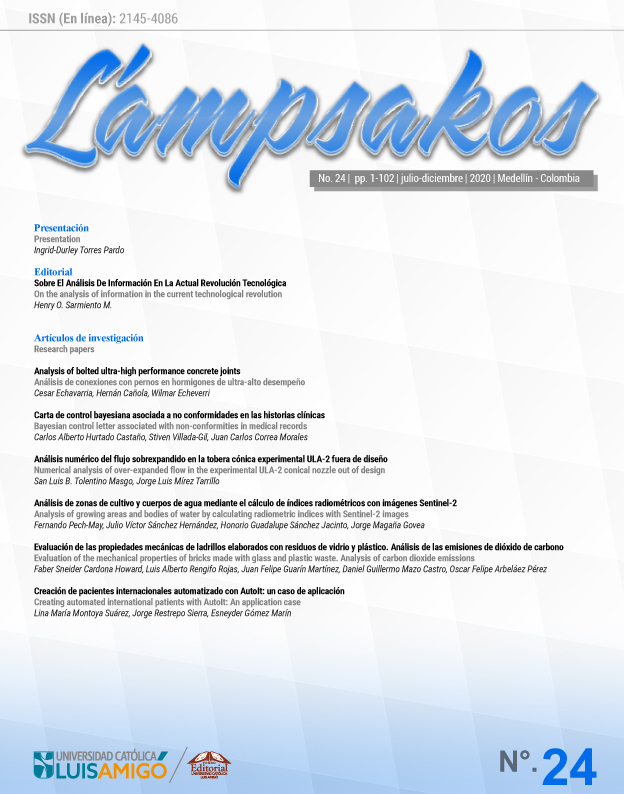Bayesian control letter associated with non-conformities in medical
DOI:
https://doi.org/10.21501/21454086.3362Keywords:
Control chart, Delphi method, Bayesian statistics, Statistical processes control, Elicitation, Ishikawa, A priori distribution, A posteriori probability distribution, Variable confidence interval, R statistical software.Abstract
In this work, using a commonly used industrial tool, such as control charts, was explored in a purely social environment, specifically in health. It was intended to present a method to introduce this easy-to-use tools-based concept and implementation. Based on the technique proposed by Ishikawa [1] as the first instance of the process, it is followed by the implementation of the Delphi methodology in two rounds and ending with a third round of Delphi, using the freehand elicitation method. This process turned out to be novel due to the estimation of the Bayesian control limits, the estimation of the a priori distribution by freehand, consulting experts, and the determination of a posteriori predictive distribution. These
allow the permanent updating of the control limits in a social process, as far as we know, not used in the literature. This result will allow the generation of early alerts to control the process, either due to the unexpected increase in non-conformities or because the innovations are surprisingly less than expected according to the posterior probability distribution.
Downloads
References
K. Ishikawa, Guide to Quality Control. Tokio, Japan: Asian Productivity Organization, 1986.
W. Woodall and M. Mahmoud, “The Inertial Properties of Quality Control Charts,” Technometrics, vol. 46, no. 47, pp. 425-436, 2005, doi: https://doi.org/10.1198/004017005000000256
J. Juran y F. Gryna, Manual de control de calidad. Madrid, España: McGraw-Hill, 1993.
S. Limaye, C. Mastrangelo and D. Zerr, “A case study in monitoring hospital associated infections with count control charts,” Quality Engineering, vol. 20, no. 4, pp. 404-413, 2008, doi: https://doi.org/10.1080/08982110802334120
W. Chiu and M. Leung, “A new Bayesian approach to quality control charts,” Metrika, vol. 2, no. 1, pp. 243-253, 1980, doi: https://doi.org/10.1007/BF01893602
R. Walpole, Probabilidad y Estadística para Ingenieros. México D.F., México: Prentice – Hall Hispanoamerica S.A., 1999.
W. Deming, Out of the Crisis. Cambridge, Inglaterra: M.I.T. Press Cambridge M.A., 1986.
W. Shewhart, “Quality control charts”. Bell System Technical Journal, vol. 5, no. 4, pp. 593-603, 1926. https://doi.org/ 10.1002/j.1538-7305.1926.tb00125.x
H. Gutiérrez, “Cartas de Control Bayesianas para Atributos y el Tamaño de Subgrupo Grande en la Carta p,” Revista Colombiana de Estadística, vol. 29, no. 2, pp. 163-180, 2006.
https://revistas.unal.edu.co/index.php/estad/article/view/29180
B. Colosimo, and E. del Castillo, Bayesian Process Monitoring - Control and Optimization. Boca Raton, Estados Unidos: Chapman and Hall/CRC-Taylor and Francis Group, 2007.
P. Tsiamyrtzis, A Bayesian Approach to Quality Control Problems, PhD thesis, Faculty of the Graduate School, University of Minesota, 2000.
Y. Zhijian, “Multivariate Bayesian Process Control”, PhD thesis, Mechanical and Industrial Engineering, University of Toronto, 2008.
P. Tsiamyrtzis, and D. Hawkins, “A Bayesian Scheme to Detect Changes in the Mean of a Short-Run Process,” Technometrics, vol. 47, no. 4, pp. 446456, 2005, doi: https://doi.org/10.1198/004017005000000346
J. Bernardo and A. Smith, Bayesian Theory. New York, United States: Wiley and Sons, 1994.
R. Marcellus, “Bayesian Statistical Process Control,” Quality Engineering, vol. 20, no. 1, pp. 113-127, 2008, doi: https://doi.org/10.1080/08982110701509046
J. Marin, and C. Robert, Bayesian Core. A Practical Approach to Computational Bayesian Statistics. New York, United States: Springer, 2007.
R. Khatiwada, and A. Sthapit, “An application of bayesian method in packaged food quality control,” Nepal Journal of Science and Technology, vol. 9, pp. 41-48, 2008, doi: https://doi.org/10.3126/njst.v9i0.3163
M. Grime, and G. Wright, “Delphi Method,” Wiley StatsRef: Statistics Reference Online, 2016, doi: https://doi.org/10.1002/9781118445112.stat07879
R. Clement, and R. Winkler, “Combining Probability Distribution from Experts in Risk Analysis,” Risk Analysis, vol. 19, no. 2, pp. 187-203, 1999. https://faculty.fuqua.duke.edu/~clemen/bio/Published%20Papers/28.CombiningDistributions-Clemen&Winkler-RA-99.pdf
R. Clement, and R. Winkler, “Combining Economic Forecasts,” Journal of Business & Economic Statistics, vol. 4, no. 1, pp. 39-46, 1986, doi: https://doi.org/10.2307/2583199
T. Benaglia, D. Chauveau, D. Hunter and D. Young, “Mixtools: An R Package for Analyzing Finite Mixture Models,” Journal of Statiscal Software, vol. 32, no. 6, pp. 1-29, 2009.
R Core Team, “R: A Language and Environment for Statistical Computing”. Vienna, Austria: R Foundation for Statistical Computing, 2013.
Downloads
Published
How to Cite
Issue
Section
License
In accordance with national and international copyrights, as well as publishing policies of "Fundación Universitaria Luis Amigó" and its Journal "Lámpsakos" (indexed with ISSN : 2145-4086), I (we ) hereby manifest:1. The desire to participate as writers and submit to the rules established by the magazine publishers.
2. The commitment not to withdraw the manuscript until the journal finishes the editing process of the ongoing issue.
3. That article is original and unpublished and has not been nominated or submitted together in another magazine; therefore, the rights of the article in evaluation have not been assigned in advance and they do not weigh any lien or limitation for use.
4. The absence of conflict of interest with commercial institution or association of any kind
5. The incorporation of the quotes and references from other authors, tending to avoid plagiarism. Accordingly, the author affirms that the paper being published do not violate copyright, intellectual property or privacy rights of third parties. Morover, if necessary there is a way of demonstrating the respective permits original copyright to the aspects or elements taken from other documents such as texts of more than 500 words, tables, graphs, among others. In the event of any claim or action by a third party regarding copyright on the article, the author (s) will assume full responsibility and come out in defense of the rights herein assigned. Therefore, for all purposes, the Journal "Lámpsakos" of the "Fundación Universitaria Luis Amigó" acts as a third party in good faith.
6. In the event of the publication of the article, the authors free of charge and on an exclusive basis the integrity of the economic rights and the right to print, reprint and reproduction in any form and medium, without any limitation as to territory is concerned, in favor of the Journal "Lámpsakos" of the "Fundación Universitaria Luis Amigó".








